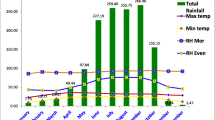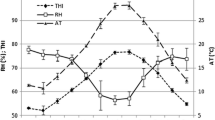Abstract
Long-term assessments of thermal responses of housed Jersey cows raised in tropical conditions were performed to investigate the effect of climate environment on their physiological performance and thermal equilibrium. Twelve Jersey dairy cows with 326.28 ± 30 kg of body weight, 17.66 ± 1.8 of milk yield, and 165.5 ± 6.8 of days in milking were assigned in two 12 × 12 Latin square designs. Air temperature, relative humidity, partial vapor pressure, direct and diffuse short-wave solar radiation and black globe temperature under the shade, and direct sunlight were recorded. Physiological responses as respiratory rate (RR, breaths min−1), ventilation (VE, L s−1), proportion (%) of oxygen (O2) and carbon dioxide (CO2), saturation pressure (PS{TEXH}), and air temperature (TEXH, °C) of the exhaled air were assessed protected from solar radiation and rain. Rectal temperature (TR, °C), skin temperature (TEP, °C), and hair coat surface temperature (TS, °C) were also recorded. The thermal equilibrium was determined from biophysical equations according to the principles of the energy conservation law in a control volume. Exploratory and confirmatory analyses were performed from principal components and by the least square method, respectively. The cows were evaluated under range of ambient air temperature from 26 to 35 °C, relative humidity from 27 to 89%, and short-wave radiation from 0 to 729 W m−2. Exploratory and confirmatory analyses demonstrated that a similar level of nocturnal and diurnal air temperatures evoked distinct (P < 0.05) responses for rectal (TR, °C) and skin (TEP, °C) temperatures, ventilation (VE, L s−1), tidal volume (TV, L breaths−1), and oxygen consumption (∆O2, %) and carbon dioxide output (∆CO2, %), clearly revealing an endogenous rhythm dependence. In conclusion, these findings clarify how the circadian rhythmicity of the thermal environment and animal’s biological clock dictate dynamics of heat generated by metabolism, dissipated to the environment and physiological parameters of the housed Jersey cows raised in tropical condition; therefore, it is fundamental to help us to understand how the Jersey dairy cows under tropics are affected by the climatic conditions, leading to better ways of the environmental management.






Similar content being viewed by others
References
Aschoff J (1981) Thermal conductance in mammals and birds: its dependence on body size and circadian phase. Comp Biochem Physiol 69:611–619
Berman A, Folman Y, Kaim M, Mamen M, Herz Z, Wolfenson D, Arieli A, Graber Y (1985) Upper critical temperatures and forced ventilation effects for high-yielding dairy cows in a subtropical climate. J Dairy Sci 68:1488–1495
Berman A (2011) Invited review: are adaptations present to support dairy cattle productivity in warm climates? J Dairy Sci 94:2147–2158
Camerro LZ, Maia ASC, Neto MC, Costa CCM, Castro PA (2016) Thermal equilibrium responses in Guzerat cattle raised under tropical conditions. J Therm Biol 60:213–221
da Silva RG (1999) Estimativa do balanço térmico por radiação em vacas Holandesas expostas ao sol e à sombra em ambiente tropical. Revista Bras Zootec 28(6):1403–1411
da Silva RG (2000) Um modelo para a determinação do equilíbrio térmico de bovinos em ambientes tropicais. Revista Bras Zootec 29(4):1244–1252
Da Silva RG, Guilhermino MM, Morais DAEF (2010) Thermal radiation absorbed by dairy cows in pasture. Int J Biometeorol 54:5–11. https://doi.org/10.1007/s00484-009-0244-1
Da Silva RG, La Scala JRN, Lima-Filho AE, Catharin MC (2002) Respiratory heat loss in the sheep: a comprehensive model. Int J Biometeorol, Berlin 46:136–140
Da Silva RG, La Scala N, Tonhati H (2003) Radiative properties of the skin and hair coat of cattle and other animals. Trans ASABE 46(3):913–918
Da Silva RG, Maia ASC (2013) Principles of animal biometeorology. Springer, New York (Ed. 1)
Da Silva RG, Maia ASC, Costa LLM, Queiroz JPAF.(2012) Latent heat loss of dairy cows in an equatorial semi-arid environment. Int J Biometeorol (Print) , 56: 927–932
De Melo Costa CC, Maia ASC, Nascimento ST, Nascimento CCN, Fonsêca VFN, Chiquitelli Neto M (2017) Thermal balance of Nellore cattle. Int J Biometeorol 74:317–324. https://doi.org/10.1016/j.jtherbio.2018.04.014
da Silva RG, Maia ASC, de Macedo Costa LL, de Queiroz JPAF (2012) Latent heat loss of dairy cows in an equatorial semi-arid environment. Int J Biometeorol 56(5):927–932
De Melo Costa CC, Maia ASC, Nascimento ST, Nascimento CCN, Fonsêca VFN, Chiquitelli Neto M (2018a) Thermal balance of Nellore cattle. Int J Biometeorol 74:317–324. https://doi.org/10.1016/j.jtherbio.2018.04.014
De Melo Costa CC, Maia ASC, Brown-Brand M; Chiquitelli Neto M, Fonsêca VFN (2018) Thermal equilibrium of Nellore cattle in tropical conditions: an investigation of circadian pattern Int. J Biometeorol: https://doi.org/10.1007/s00484-0171349-6
Gebremedhin KG, Cramer CO, Porter WP (1981) Predictions and measurements of heat production and food and water requirements of Holstein calves in different environments. Trans of ASAE 24(3):0715–0720. https://doi.org/10.13031/2013.34326
Hill JO, Wyatt HR, Peters JC (2012) Energy balance and obesity. Circulation 126:126–132. https://doi.org/10.1161/CIRCULATIONAHA.111.087213
Keren EN, Olson BE (2006) Thermal balance of cattle grazing winter range: model application. J Anim Sci 84(5):1238–1247. https://doi.org/10.2527/2006.8451238x
Kibler HH (1960) Oxygen consumption in cattle in relation to rate of increase in environmental temperature. Nature 186:972–973
Kibler HH, Brody S (1954) Influence of diurnal temperature cycles on heat production and cardiorespiratory activities in Holstein and Jersey cows. Research bulletin 601, University of Missouri College of Agriculture Agricultural Experiment Station, February
Littell R C, Freund R J (1991) Spector, P. C. SAS® System for linear models, Third Edition, Cary, NC: SAS Institute Inc., 329p
Maia ASC, da Silva RG, Bertipaglia ECA (2003) Características do pelame de vacas Holandesas em ambiente tropical: um estudo genético e adaptativo. Revista Bras Zootec 32(4):843–853
Maia ASC, da Silva RG, Loureiro CMB (2005a) Sensible and latent heat loss from the body surface of Holstein cows in a tropical environment. Int J Biometeorol 50:17–22. https://doi.org/10.1007/s00484-005-0267-1
Maia ASC, da Silva RG, Loureiro CMB (2005b) Respiratory heat loss of Holstein cows in a tropical environment. Int J Biometeorol 49:332–336. https://doi.org/10.1007/s00484-004-0244-0
Maia ASC, da Silva RG, Nascimento ST, Nascimento CCN, Pedroza HP, Domingos HGT (2014) Thermoregulatory responses of goats in hot environments. Int J Biometeorol 59:1025–1033
Maia ASC, Nascimento ST, Nascimento CCN, Gebremedhin KG (2016) Thermal equilibrium of goats. J Therm Biol 58:43–49. https://doi.org/10.1016/j.jtherbio.2016.03.012
Maloney SK, Meyer LR, Blache D, Fuller A (2013) Energy intake and the circadian rhythm of core body temperature in sheep. Physiol Rep 1:01–09
Ostojić-Andrić D, Petrović MM, Pantelić V, Petrović VC, Nikśić D, Lazarević M, Marinković M (2017) Production performance of Holstein Friesan cattle under breeding-selection program in Central Serbia. Proceedings of Scientific Conference with International Participation “Animal Science - Challenges and Innovations”, Sofia, Bulgaria
Santos SGCG, Saraiva EP, Pimenta Filho EC, Gonzaga Neto S, Fonsêca VFC, Pinheiro A d C, Almeida MEV, de Amorim MLCM (2017) The use of simple physiological and environmental measures to estimate the latent heat transfer in crossbred Holstein cows. Int J Biometeorol 61(2):217–225
Silva RG (2008). Biofísica ambiental – os animais e seu ambiente. FUNEP, Jaboticabal, SP, Brazil
Silva RG, Arantes-Neto JG, Holtz Filho SV (1988) Genetic aspects of the variation of the sweating rate and coat characteristics of Jersey cattle. Braz J Genet (11):335–347
Silva RG, Maia ASC (2011) Evaporative cooling and cutaneous surface temperature of Holstein cows in tropical conditions. R Bras Zootec 40:1143–1147
Todini L (2007) Thyroid hormones in small ruminants: effects of endogenous, environmental and nutritional factors. Animal 1(7):997–1008. https://doi.org/10.1017/S1751731107000262
Usman T, Qureshi MS, Yu Y, Wang Y (2013) Influence of various environmental factors on dairy production and adaptability of Holstein cattle maintained under tropical and subtropical conditions. Adv Environ Biol 7(2):366–372
Vilela D, Resende JCD, Leite JB, Alves E (2017) A evolução do leite no Brasil em cinco décadas. Revista de Política Agrícola, v. 26, n. 1, p 5–24
Williams R, Scholtz MM, Neser FWC (2016) Geographical influence of heat stress on milk production of Holstein dairy cattle on pasture in South Africa under current and future climatic conditions. South African Journal of Animal Science 46(4):441
Acknowledgments
We would like to show our gratitude to the Agência Paulista de Tecnologia dos Agronegócios – APTA of Ribeirão Preto, SP, Brazil, for sharing their animals and the structure so that it was possible to carry out the research.
Funding
This study was supported by Fundação de Amparo à Pesquisa do Estado de São Paulo (FAPESP), process numbers 2011/17388-6 and 2014/09639-7.
Author information
Authors and Affiliations
Corresponding author
Rights and permissions
About this article
Cite this article
Nascimento, S.T., Maia, A.S.C., de França Carvalho Fonsêca, V. et al. Physiological responses and thermal equilibrium of Jersey dairy cows in tropical environment. Int J Biometeorol 63, 1487–1496 (2019). https://doi.org/10.1007/s00484-019-01734-w
Received:
Revised:
Accepted:
Published:
Issue Date:
DOI: https://doi.org/10.1007/s00484-019-01734-w




